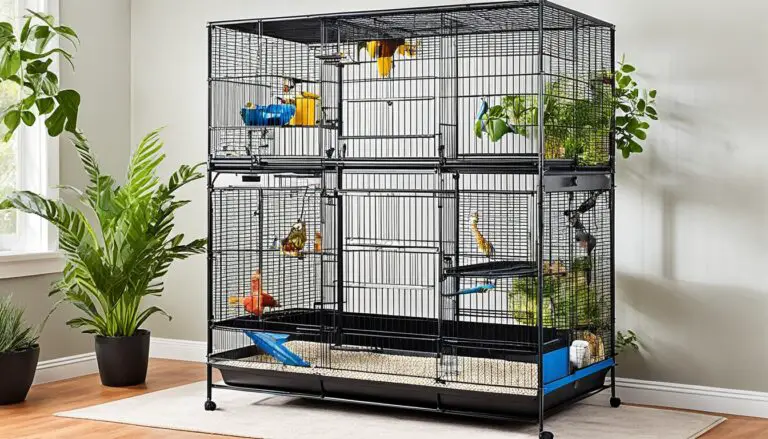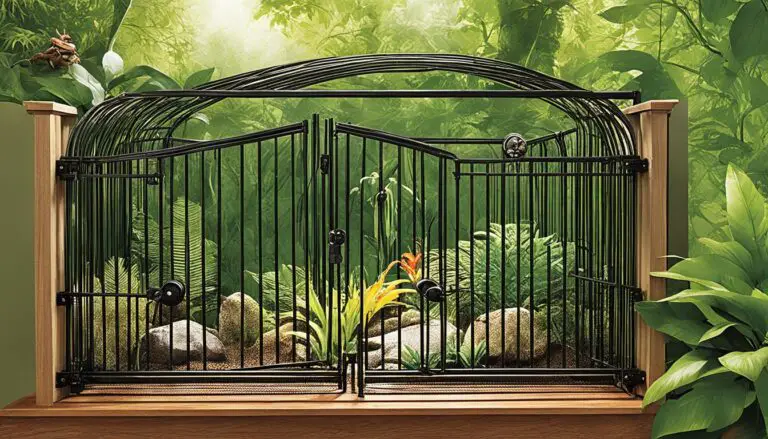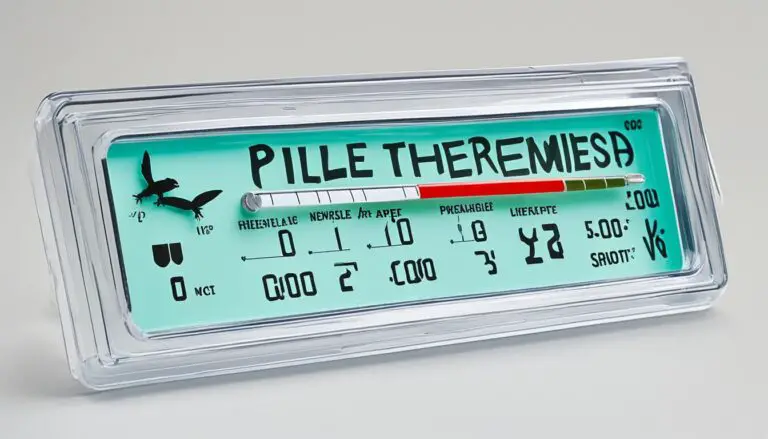Exotic Pet Housing Substrate: Top Choices
Choosing the right housing substrate is essential for creating an ideal habitat for your exotic pet. The type of substrate you use will depend on your pet’s species and specific needs. Let’s explore some of the best options for exotic pet housing substrates.
Key Takeaways:
- Research your pet’s natural habitat to understand the climate and vegetation of their native environment.
- Consider the specific requirements of your pet’s species when choosing a substrate.
- Wood bedding, paper bedding, reptile carpet, and coconut fiber bedding are popular substrate choices.
- Factors to consider include temperature control, absorbency, odor control, and safety of the substrate.
- Maintain regular cleaning habits and replace the substrate to prevent bacterial growth.
Researching Your Pet’s Natural Habitat
Before selecting a housing substrate for your exotic pet, it’s crucial to conduct thorough research on their natural habitat. Understanding their native environment, including the climate, temperature, humidity, and vegetation, will provide valuable insights into the type of habitat they require.
By researching your pet’s natural habitat, you can create a living space that closely mimics their native surroundings, promoting their overall well-being and happiness. Here are some key factors to consider:
- Climate: Familiarize yourself with the typical climate patterns and conditions in your pet’s natural habitat. This knowledge will help you replicate the appropriate temperature and humidity levels in their enclosure.
- Temperature: Different species thrive in specific temperature ranges. Understanding the temperature preferences of your exotic pet will allow you to select a housing substrate that provides optimal thermal comfort.
- Humidity: Some exotic pets require higher levels of humidity to thrive. Researching their natural habitat will help you choose a substrate that can retain moisture, creating the ideal humidity levels for your pet.
- Vegetation: Take note of the types of plants and foliage that are present in your pet’s natural habitat. Incorporating similar vegetation in their enclosure can provide a sense of familiarity and enrichment.
Researching your pet’s natural habitat equips you with the knowledge needed to replicate their ideal living conditions. By selecting a housing substrate that closely resembles their natural habitat, you are creating a comfortable and appropriate environment for your beloved exotic pet.
| Climate | Temperature | Humidity | Vegetation |
|---|---|---|---|
| Sunny and hot | 25-35°C (77-95°F) | High humidity | Lush tropical plants |
| Mild and temperate | 18-25°C (64-77°F) | Moderate humidity | Grasses and shrubs |
| Humid and rainy | 20-30°C (68-86°F) | High humidity | Lush rainforest vegetation |

Researching your pet’s natural habitat is like unlocking the key to their comfort and well-being. By recreating their native environment, you are ensuring a happy and enriched life for your exotic pet.
Choosing the Right Substrate
When it comes to selecting the perfect housing substrate for your exotic pet, there are several factors to consider. The size, material, and design of the substrate should be tailored to meet the specific needs of your pet. Understanding their habitat requirements and natural behaviors will help you make an informed decision.
Size: Different pets have different space requirements. Some may thrive in enclosures with vertical space, allowing them to climb and explore, while others prefer a larger horizontal area to roam around. Consider the needs of your pet’s species and ensure they have ample room to move and engage in their natural behaviors.
Material: The choice of substrate material will depend on the type of pet you have. For reptiles, options such as reptile carpet or coconut fiber bedding can mimic their natural environment and provide a comfortable surface for them to rest and move on. Small mammals, on the other hand, may benefit from wood bedding or paper bedding, which offer nesting opportunities.
Design: The design of the substrate should also be taken into account. Some pets may require a substrate that can be easily burrowed into, while others may prefer a more solid surface. Understanding your pet’s preferences and natural instincts will help you select the right design.
Research: To make the best choice for your exotic pet, conduct thorough research on their species-specific requirements. Look for information on what type of substrate they would encounter in their natural habitat and try to replicate it as closely as possible. This will ensure your pet feels comfortable and at home in their enclosure.
By carefully choosing the right substrate for your exotic pet, you are creating an environment that promotes their well-being and allows them to thrive. Let’s now explore some common substrate options available for exotic pets.

Substrate Options for Exotic Pets
| Substrate | Advantages | Disadvantages |
|---|---|---|
| Wood Bedding | – Offers natural appeal – Provides nesting opportunities – Helps maintain humidity levels |
– May develop mold or fungus if not properly maintained |
| Paper Bedding | – Economical – Easy to change and clean – Provides soft and comfortable surface |
– Less aesthetically pleasing – Not suitable for pets that may ingest the bedding |
| Reptile Carpet | – Easy to clean and maintain – Provides a solid surface for movement – Mimics natural habitat for reptiles |
– May require additional accessories for burrowing pets |
| Coconut Fiber Bedding | – Natural and eco-friendly – Retains moisture effectively – Ideal for tropical and arboreal species |
– May require frequent misting to maintain humidity levels |
Different Substrate Types
When it comes to selecting the right substrate for your exotic pet’s habitat, there are several options to choose from. Each type of substrate offers unique benefits and is suitable for different species and environments. Here are some of the most commonly used substrates:
Wood Bedding
Wood bedding is a popular choice among exotic pet owners. It is available in various forms such as shavings, pellets, and chips. Wood bedding provides a comfortable surface for your pet to explore and burrow in, mimicking their natural habitat. It also has excellent absorbency, helping to control moisture and odor within the enclosure.
Paper Bedding
Paper bedding, including shredded newspaper and paper towels, is another commonly used substrate. It is soft, low-dust, and easy to clean. Paper bedding is an affordable option that provides a comfortable and safe environment for your exotic pet.
Reptile Carpet
For reptiles and some small animals, reptile carpet is a preferred option. This substrate is made of textured fabric or artificial grass and offers a natural feel under your pet’s feet. Reptile carpet is easy to maintain, reusable, and provides a secure grip for climbing and burrowing.
Coconut Fiber Bedding
Coconut fiber bedding, also known as coir, is an excellent choice for pets that require high humidity levels. It retains moisture well and helps regulate humidity within the enclosure. Coconut fiber bedding is made from the fibrous material found in coconut husks and provides a natural and comfortable substrate for your pet.
| Substrate Type | Main Features | Suitability |
|---|---|---|
| Wood Bedding | Comfortable, absorbs moisture and odor | Wide range of species |
| Paper Bedding | Soft, easy to clean, affordable | Small animals, reptiles, birds |
| Reptile Carpet | Textured, reusable, provides grip | Reptiles, small animals |
| Coconut Fiber Bedding | Retains moisture, regulates humidity | Reptiles, amphibians |
When choosing a substrate for your exotic pet, consider their specific needs and the requirements of their native habitat. Provide a comfortable and safe environment that allows them to exhibit natural behaviors and thrive.
Substrate Considerations
Choosing the right substrate for your exotic pet involves considering several important factors. These include temperature control, absorbency, odor control, and the safety of the substrate.
Temperature control is crucial for certain exotic pets that require specific temperature ranges to thrive. By selecting a substrate that can help maintain the appropriate temperature, you can ensure the comfort and well-being of your pet.
Absorbency is another key consideration, especially for pets that produce a significant amount of waste or require high levels of moisture. An absorbent substrate can help keep the enclosure clean and provide a hygienic environment for your pet.
Odor control is essential to maintain a pleasant and fresh-smelling habitat. Look for substrates that have odor-absorbing properties to minimize unpleasant smells and create a more enjoyable living space for both you and your pet.
Safety should always be a top priority when choosing a substrate. Avoid using substrates that could pose a risk to your pet’s health, such as those that are sharp, toxic, or easily ingested. Opt for substrates specifically designed for the species of your exotic pet to ensure their safety and well-being.
By carefully considering these substrate considerations, you can create a comfortable and safe habitat that meets the unique needs of your exotic pet.
Maintenance and Cleaning
Regular maintenance and cleaning are essential to keep your exotic pet’s habitat clean and healthy. By establishing proper cleaning habits, you can prevent the growth of harmful bacteria and ensure your pet’s overall well-being.
Here are some key cleaning practices to follow:
- Regularly clean and disinfect the enclosure: Thoroughly clean and disinfect the enclosure at least once a week, or more frequently if needed. Use pet-safe cleaning products and follow the manufacturer’s instructions for proper usage. Pay close attention to areas where bacteria can accumulate, such as corners, hiding spots, and water or food bowls.
- Replace the substrate: As part of your cleaning routine, regularly replace the substrate in your pet’s enclosure. Substrates like wood bedding and coconut fiber can degrade over time and lose their effectiveness in absorbing moisture and controlling odor. By replacing the substrate, you can maintain a clean and hygienic environment for your pet.
- Be mindful of potential hazards: During cleaning, carefully inspect the enclosure for any potential hazards that may harm your pet. Remove any sharp objects, loose wires, or small items that could be ingested. Additionally, check for signs of wear or damage to the enclosure and replace any worn-out or broken parts.
“Regular maintenance and cleaning are essential to keep your exotic pet’s habitat clean and healthy.”
“Cleanliness is vital for the health and happiness of your exotic pet. By maintaining a clean habitat, you not only prevent bacterial growth but also create a safe and comfortable environment for your furry friend.”
Preventing Bacterial Growth
Bacterial growth can negatively impact your exotic pet’s health. To prevent bacterial growth, follow these additional tips:
- Properly dispose of waste: Dispose of your pet’s waste promptly and hygienically. Remove solid waste daily and dispose of it in a designated waste bin. If using a substrate that absorbs liquid waste, replace the soiled substrate promptly to prevent the growth of bacteria.
- Monitor humidity levels: Pay attention to the humidity levels in your pet’s enclosure, as excessive moisture can create a favorable environment for bacterial growth. Use a hygrometer to monitor humidity and adjust as needed. Avoid allowing the enclosure to become damp or overly humid.
- Provide proper ventilation: Ensure adequate airflow within the enclosure to prevent stagnant air, which can contribute to bacterial growth. Proper ventilation helps maintain a clean and odor-free environment.
- Keep food and water clean: Regularly clean your pet’s food and water bowls to prevent the growth of bacteria. Replace stale or contaminated food promptly and provide fresh, clean water at all times.
Example table:
| Substrate | Bacterial Growth Prevention |
|---|---|
| Wood Bedding | Regularly replace soiled bedding to maintain cleanliness and prevent bacterial growth. |
| Paper Bedding | Dispose of soiled bedding promptly and replace with fresh bedding to prevent bacterial proliferation. |
| Reptile Carpet | Clean and disinfect the carpet regularly to prevent the buildup of bacteria. |
| Coconut Fiber Bedding | Replace soiled coconut fiber bedding regularly to inhibit bacterial growth and maintain a clean environment. |
Cleanliness is vital for the health and happiness of your exotic pet. By maintaining a clean habitat, you not only prevent bacterial growth but also create a safe and comfortable environment for your furry friend.
Conclusion
Creating a suitable habitat is essential for the well-being of your exotic pets. By providing an environment that closely resembles their natural habitat, you are ensuring their physical and mental health. One of the key components of a suitable habitat is selecting the right housing substrate.
Investing time and effort into researching and choosing the appropriate substrate for your exotic pet is crucial. This substrate will not only contribute to their overall happiness but also promote their ability to thrive as a companion. Consider factors such as their species, specific needs, and natural behaviors when making your selection.
Remember, consulting with experts and professionals in exotic pet care can provide valuable insights and guidance. They can offer expert advice on creating a habitat that meets the unique requirements of your exotic pet, ensuring you provide the best possible home for your beloved companion. By prioritizing their well-being and replicating their natural environment as closely as possible, you are fostering a happy and thriving bond with your exotic pet.
FAQ
What factors should I consider when choosing a housing substrate for my exotic pet?
What are the different types of substrates available for exotic pets?
What considerations should I keep in mind when choosing a substrate for my exotic pet?
How often should I clean and maintain my exotic pet’s habitat?
Why is it important to replicate my exotic pet’s natural environment?
Source Links
- https://www.tampavet.com/exotics-blog/husbandry/
- https://www.dogwoodvethospital.com/blog-resources/blog/2023/8/24/creating-an-ideal-habitat-for-your-exotic-pet/
- https://www.thesprucepets.com/bedding-and-substrate-options-for-pet-reptiles-1239410
Peter Stones is the founder of Exotic Pets Place, the leading online resource for exotic pet care information.
With over 10 years of hands-on exotic pet ownership experience, he is deeply passionate about sharing his expertise to help others properly care for their unusual pets.
When he's not writing extensively researched articles or connecting with fellow exotic pet enthusiasts worldwide, you can find Peter at home tending to his own beloved menagerie of exotic animals.





![How to Create a Safe Outdoor Space for Your Exotic Pet [Guide], wood house with a porch](https://exoticpetsplace.com/wp-content/uploads/2023/06/How-to-Create-a-Safe-Outdoor-Space-for-Your-Exotic-Pet-Guide-wood-house-with-a-porch-768x512.jpg)

